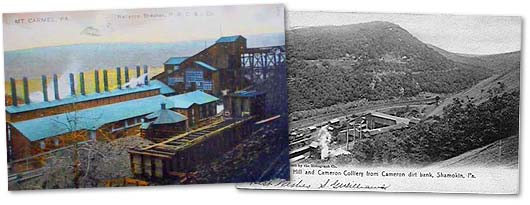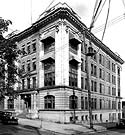
When Coal Was King

(LEFT): Reliance Breaker, Mt. Carmel, PA. (RIGHT): Goss Hill and Cameron olliery, Shamokin, PA, circa 1905. *[1]
Anthracite Discovered
The first discovery of coal in eastern Pennsylvania can supposedly be traced back well over 200 years ago to Schuylkill County. Legend has it that in 1790 a woodsman and trapper named Necho Allen, came to the area in search of timber and game. One night, he built his campfire beneath a shelter rock and fell asleep. During the predawn hours he was awakened by a glowing light and great heat coming from the ground. Necho to his astonishment had found coal, his fire had not been built on rock, but on an outcropping of anthracite.
By 1817, a number of small individual mines had been opened. In 1822 it was reported that 1488 tons of anthracite had been shipped by canal from the Schuylkill region, and the industry, as a business, had its official beginnings. Development was rapid, and by 1825, the Schuylkill Navigation Company had completed the Schuylkill Canal, which allowed for the transport of anthracite from Pottsville to Philadelphia in barges capable of holding 200 tons.*[2]
In 1842, the first train by the P & R Railroad (Philadelphia & Reading) from Philadelphia made the trip to Pottsville to compete for the coal trade. Trains were able to haul three times as much anthracite than barges. To counter this threat, the Schuylkill Navigation Company began a major expansion program and also entered into a price fixing arrangement with the railroad, temporarily stabilizing rates for transporting anthracite. However, the decade would be the last prosperous one for the canal, transporting 1,700,000 tons of cargo during the peak year of 1859. As impressive as this was, the P & R was able to haul well over 2,500,000 tons by rail during this same period.
Ultimately the efficiency, speed and greater tonnages afforded by the newer technology of rail transport triumphed. The 1860s marked the beginning of a decline for the canal from which it would never recover. Surrendering to the competition in 1870, the Schuylkill Navigation Company leased its waterway to the Philadelphia and Reading Railroad for a period of 979 years (eventually ceasing operations completely before 1920).*[3]
The Rush is On
The use of anthracite soared as the “Industrial Revolution” swung into high gear in the heavily industrialized northeast. By the late 1870s there were over 170 operations in the Schuylkill, Lehigh and Mahanoy regions employing as many as 19,000 men and boys in the mines and on the breakers.*[4]Anthracite was fast becoming an indispensable commodity with a wide range of uses including: metals/chemicals processing, ore reduction, steel refining/purification, the manufacture of bricks, graphite, carbides, electrodes, the production of gas, hydrocarbons and coke, the purification of water and a smokeless source of combustion for home heating, industrial applications and fuel for the P & R’s fleet of steam engines.
1871, the P & R established a subsidiary, the Philadelphia & Reading Coal and Iron Company (P & R C and I) to capitalize on the lucrative demand for anthracite and gain control of much of the vast deposits residing within Pennsylvania.*[5]Eventually, both the P & R and the P & R C and I became entities of the Reading Company, then a holding company created by the P & R in an effort to satisfy government antitrust laws. The Supreme Court felt otherwise and in 1924, the Reading Company was ordered to divest itself of the P & R C and I. Despite this forced separation, the Reading would continue to profit handsomely from the transport of anthracite over the next quarter century.
Declining Fortunes
Unfortunately, the prosperity was not to last. The decades following World War II saw a steep reversal in the fortunes of the Reading as the demand for anthracite lessened and the country began to increasingly rely on oil and natural gas as primary sources of fuel. Attempts were made to cut costs and grow more on-line and bridge traffic to replace lost anthracite revenue. However, with the Pennsylvania Railroad-New York Central merger in 1968, these efforts ultimatley proved to be fruitless and in 1971, the Reading declared bankruptcy for the very last time.*[6]After an unsuccessful bid at reorganization, all rail assets were conveyed to CONRAIL on April 1st, 1976.
There is a brighter ending though for the Philadelphia & Reading Coal & Iron Company and its anthracite operations. In 1956, it changed its corporate title to the Philadelphia & Reading Corporation, Five years later, it sold off what remained of its coal operations, including the Reading Anthracite Division to its present day owners. Today, Reading Anthracite remains the largest anthracite mining company in the world. More information can be found at their site: www.readinganthracite.com.
Pennsylvania Coal

St. Nicholas Breaker, constructed in 1931 just outside of Mahanoy City, PA (and served by the RDG), was at one time, the world’s largest and most modern coal preparation plant. Today, no longer used, there is growing support to preserve the breaker as an industrial interpretive center as part of the Schuylkill Heritage Corridor. (click here for a schematic of the breaker operation)

Reading Anthracite origins date back to 1871 when its predecessor, the Philadelphia Reading Coal and Iron Company (P & R C and I) was chartered by the P & R Pictured here is their office building in Pottsville, PA, circa 1920. (photo courtesy Reading Anthracite).

For additional information about coal mining and its history in Pennsylvania, check out these sites:
Tribute to the Anthracite Miners in Pennsylvania
Coal: Ancient Gift Serving Modern Man
Notes:
|
 |
 |
 |
 |
|
|